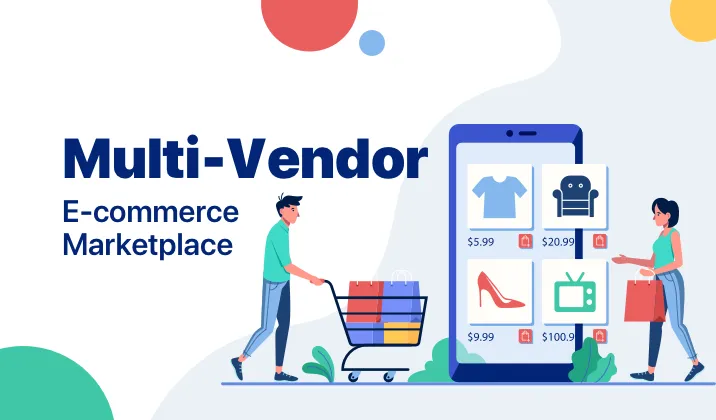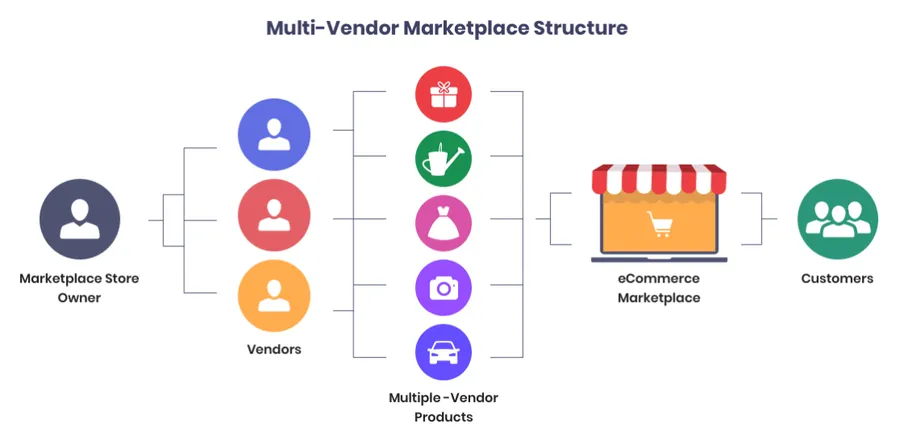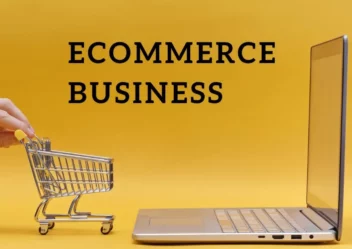How to Choose a Multi-Vendor eCommerce Platform?
Are you dreaming of building the next Amazon or Etsy? Or perhaps you have a niche idea for an online marketplace connecting unique sellers with eager buyers? Whatever your vision, choosing the right multi-vendor eCommerce platform is crucial to your success.
This comprehensive guide will equip you with the knowledge and insights to navigate the world of multi-vendor eCommerce platforms and select the perfect foundation for your online marketplace.
Lusion – Multipurpose eCommerce Shopify Theme
We provide an amazing Shopify theme with fast and responsive designs. Let’s find out!
What is a Multi-Vendor eCommerce Platform?

A multi-vendor eCommerce platform is a specialized software solution that enables you to create an online marketplace where multiple vendors can list and sell their products or services. It’s like building a digital shopping mall where independent businesses come together under one roof.
Platforms like Amazon, Etsy, and eBay have revolutionized online shopping by offering a vast selection of products from diverse sellers. With a multi-vendor platform, you can create a similar experience, curating a unique marketplace tailored to your specific niche.
Key features of a multi-vendor eCommerce platform:
- Centralized platform: Provides a unified online space for multiple vendors to showcase and sell their offerings.
- Individual vendor storefronts: Each vendor has a dedicated space to manage their products, inventory, orders, and customer interactions.
- Streamlined checkout process: Customers can purchase items from multiple vendors with a single transaction.
- Integrated payment processing: Facilitates secure payment collection and distribution between the platform, vendors, and customers.
- Administrative control: Offers tools for the marketplace owner to manage vendors, approve products, set commissions, and oversee platform operations.
Now that you have a clear understanding of what a multi-vendor eCommerce platform entails, let’s explore the steps involved in choosing the right one for your business.
Steps To Choose a Multi-Vendor eCommerce Platform

1. Define Your Vision and Target Audience
Before evaluating any platforms, it’s crucial to have a clear vision for your marketplace. Ask yourself these key questions:
- What specific niche will you focus on? (e.g., handmade crafts, vintage clothing, organic food, digital services)
- Who is your ideal customer? (e.g., age, demographics, interests, spending habits)
- What kind of vendors do you want to attract? (e.g., established brands, small businesses, individual creators)
- What is your revenue model? (e.g., commission on sales, subscription fees, advertising)
Defining your niche, target audience and revenue model will help you identify the features and functionalities that are most important for your platform.
2. Essential Features for a Thriving Multi-Vendor eCommerce Platform
A robust multi-vendor eCommerce platform should offer a comprehensive set of features to support your marketplace operations and growth. Here are some essential features to look for:
- Individual Vendor Dashboards: Each vendor needs a dedicated space to manage their profile, products, inventory, orders, customer communication, and payouts.
- Centralized Admin Panel: As the marketplace owner, you need a powerful admin panel to oversee all aspects of the platform. This includes managing vendor accounts, approving products, setting commissions, monitoring transactions, and analyzing performance data.
- Flexible Payment Gateways: Offer a variety of payment options (e.g., credit cards, PayPal, Stripe, Apple Pay) to cater to diverse customer preferences and ensure smooth transactions.
- Scalability: Choose a platform that can handle your growth as you onboard more vendors and experience increased traffic and sales volume.
- Customization Options: The platform should allow you to customize the design, branding, and user interface to align with your vision and create a unique marketplace experience.
- Marketing Tools: Built-in marketing features like SEO optimization, email marketing, discount management, and social media integration are crucial for driving traffic and promoting your marketplace.
- Communication Tools: Facilitate seamless communication between vendors and customers with integrated messaging or chat systems. This helps resolve queries, provide support, and build strong relationships.
- Order and Inventory Management: Efficient order management and inventory tracking are essential for smooth fulfillment and customer satisfaction. Look for features that automate order processing, provide real-time inventory updates, and streamline shipping.
- Product Catalog Management: Ensure the platform offers robust product catalog management tools that allow vendors to easily list their products, add detailed descriptions, upload high-quality images, and manage variations (e.g., size, and color).
- Reviews and Ratings: A system for collecting customer reviews and ratings can build trust and credibility for your marketplace. It also provides valuable feedback for vendors to improve their offerings.
- Mobile Responsiveness: In today’s mobile-first world, your marketplace must be optimized for mobile devices. This ensures a seamless shopping experience for customers on smartphones and tablets.
- Security: Prioritize platforms that offer robust security measures to protect sensitive data, prevent fraud, and ensure secure transactions.
3. Find the Top Multi-Vendor eCommerce Platforms
The market offers a wide range of multi-vendor eCommerce platforms, each with its strengths and weaknesses. Here are some of the leading contenders to consider:
- Multi-Vendor Marketplace: Multi-Vendor Marketplace Shopify app allows businesses to create their multi-vendor marketplace. It offers features such as compatibility with other platforms, payout handling, bulk CSV uploads, seller badges, real-time chat, and customizable seller logins.
- Marketplacer: Marketplacer enables businesses to integrate third-party seller inventory into their e-commerce platforms. It offers access to a large seller community, allowing businesses to expand their product offerings without managing additional inventory.
- CS-Cart Multi-Vendor: CS-Cart is a leading platform for quickly launching a multi-vendor e-commerce marketplace. It offers a comprehensive suite of features and has a proven track record, having helped over 50,000 companies worldwide.
- Yo!Kart: Yo!Kart is a customizable e-commerce marketplace software that caters to various industries, including fashion, furniture, healthcare, electronics, sports, and digital products. It streamlines marketplace management with features like a product catalog system, multiple payment options, and multilingual functionality.
- Nautical Commerce: Nautical Commerce offers a multi-vendor marketplace platform with tools for managing operations, including product uploads, order management, and payouts. It is flexible, customizable, and provides support and resources to help businesses succeed.
- CedCommerce: CedCommerce is a multi-channel e-commerce integration enabler that helps sellers scale their growth across multiple platforms and marketplaces. It provides tailored solutions with advanced technology and AI capabilities, enhancing performance, scalability, and user experience.
4. Consider Key Factors Beyond Features
While features are crucial, don’t overlook these critical factors when making your decision:
- Budget: Carefully consider your budget for platform fees, transaction fees, and potential development or customization costs. Some platforms offer a one-time license fee, while others operate on a monthly subscription model.
- Technical Expertise: Assess your team’s technical skills to determine if you need a user-friendly platform with a drag-and-drop interface or one that allows for extensive customization and requires coding knowledge.
- Customer Support: Reliable customer support is essential, especially during the initial setup and when troubleshooting issues. Look for platforms that offer responsive and helpful support channels.
- Community and Ecosystem: A strong community and ecosystem can provide valuable resources, support, and extensions to enhance your marketplace. Consider platforms with active forums, developer communities, and a wide range of third-party integrations.
5. Test and Explore Before Committing
Most multi-vendor eCommerce platforms offer free trials or demos. Take advantage of these opportunities to explore the platform’s interface, test its features, and get a feel for its user experience. This hands-on experience will give you valuable insights and help you make an informed decision.
Final Thoughts
Choosing the right multi-vendor eCommerce platform is a critical step in building a successful online marketplace. By carefully defining your vision, evaluating essential features, considering key factors, and testing the platforms, you can find the perfect solution to launch and grow your business. Remember that the ideal platform will align with your specific needs, budget, and technical expertise. With thorough research and careful planning, you can create a thriving online marketplace that connects vendors and customers in a seamless and engaging shopping experience.
Read more: Top 10+ eCommerce SEO Agencies



